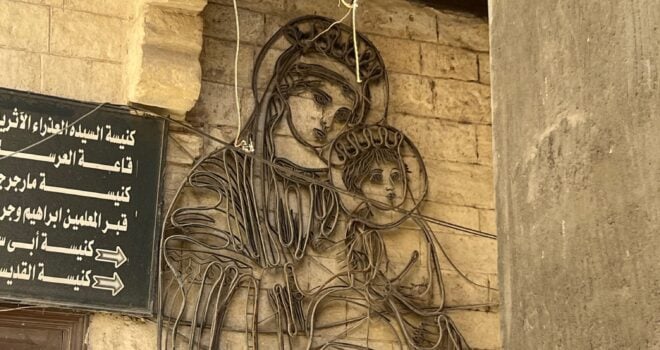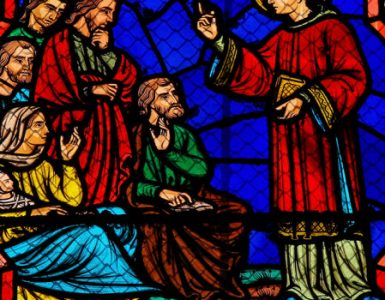When we planned a trip to Egypt, of course we wanted to see King Tut’s treasures, the Pyramids, and the Valley of the Kings, but we couldn’t leave without a visit to the King of Kings.
My husband and I were able to renew our love of travel when we became empty nesters, seeking to make every trip a pilgrimage. On this trip, we especially looked forward to visiting the Coptic Quarter in Cairo, and especially the church built on the site where the Holy Family stayed during the flight to Egypt: the Church of Abu Serga.
Arriving in Cairo
I had known there would be a contrast between the Christian quarter and the rest of Cairo, but I had not been prepared for how dramatic that contrast would be.
After delays from an air-traffic controllers’ strike on top of a 12-hour layover, we arrived in Cairo at 1am after 24+ hours of travel, and then began the hour-long drive to our Giza hotel. The streetlights cast a sour, graying-yellow light over the littered, chaotic streets, crowded with groups of young men even at that hour.
Fatigue mixed with fear as packs of dogs crossed the streets, and some vehicles even drove against traffic, their approaching headlights blinding us before they would swerve at the last second. The skyline was pierced by hundreds of minarets: not a single cross or church spire to be seen.
We have traveled through many countries, East and West. Even as secular as most Western cities have become, their Christian roots shaped them nonetheless, and they retain a measure of their Christian character. And in many Eastern countries, Christian influence is evident. But here in Cairo, there seemed to be not a flicker of Christendom.
Days later we would pass through the gates of the ancient Roman fortress and into the Coptic Quarter. Never had the warm glow of a sanctuary lamp felt so mercifully inviting than in the church of Abu Serga.
From Tourist to Pilgrim
We visited the Pyramids and the Sphynx and cruised the Nile, touring the Valleys of the Kings and Queens, and the Temples of Horus, Kom Ombo, and Philae. On the last full day of our trip, we returned to Cairo and headed for the Coptic Quarter.

We had to park a distance away and made our way through streets lined with vendors in stalls and small markets. As we approached the doors to the Babylon Gate (the famous door leading to the Coptic Quarter), the stalls gradually changed from selling mostly food to selling mostly Christian items.
After several days in Egypt, the first glimpse of a little plastic statue of Mary brought tears to my eyes.
Finally, we stood before the imposing, ancient door.
Babylon-in-Egypt
It made sense that the Christian Quarter was within a fortress. During the Roman and Byzantine periods, there was no major city in the area now known as Cairo. A Roman fortress called Babylon-in-Egypt dominated the region, and Christian communities began to flourish within the Alexandrian Patriarchate, from which the Coptic Orthodox Church traces its lineage.
The fortress fell to invading Muslim armies in AD 641, marking the beginning of Islamic rule in Egypt. Following the conquest, the local Coptic Christian population was granted certain protections in exchange for paying the jizya (a tax levied on non-Muslims).
Through the door and into the narrow streets, Christian art and symbolism surrounded us again. It was disorienting—not like cars going the wrong way on the highway disorienting, but disorienting in an intriguing, inviting way.
Art and beauty everywhere, but different somehow. Humble, and clearly the work of human hands, unlike much Renaissance art that looks flawless. And we were somewhere decidedly not Western; as a Roman Catholic, the streets, churches, museums, and shops felt familiar but not quite home in a way hard to put my finger on—maybe the home of extended family.
We headed for the Church of Abu Serga, also known as the Church of Saints Sergius and Bacchus. It is the oldest church in Cairo and one of the most significant because, according to Tradition, the Holy Family sought refuge in what is now the crypt during the flight to Egypt. The current church was built in the 4th or 5th century and is dedicated to Saints Sergius and Bacchus, Roman soldiers martyred for their Christian faith during the reign of Emperor Maximian.
The Church of Abu Serga
As we stepped into the church, we were bathed in warm candlelight and especially the red glow of the sanctuary candle. We were home at last. The air inside was cool, and the smell was earthy: a blend of old wood, stone, and frankincense. The murmurs of a small group of worshippers (I could not tell if they were praying in Coptic, Arabic, or another language) rose and fell.
And then, on the right side, I saw it: the stairway down to the underground chamber where, according to tradition, the Holy Family rested for three months during their flight into Egypt.
As I descended the worn steps, the air grew cooler still. A simple altar stood at one end, behind it an icon of Christ Pantocrator. On the left, an icon of the flight to Egypt and on the right, one of St. Joseph holding the infant Jesus. On the ground was a lighted opening revealing the top of the actual place of the Holy Family’s rest.

I thought of Mary and Joseph, weary and frightened, carrying with them their newborn Son, the Hope of the World. In that moment, I remembered moments of worry for my own children and felt Mary turning her loving gaze towards me.
Oh clement, oh loving, oh sweet Virgin Mary!
Our Flight From Egypt
Soon the time came for our fight from Egypt to our home in the U.S. After splitting up to go through the separate male and female airport security lines, we sat together at the gate and reflected that receiving a tour of Christian sites in Egypt from a non-Christian tour company was, in retrospect, a mistake.
Our guide was kind and friendly and went out of his way to share that Muslims respect Jesus. But he went on to explain that they do not believe He is God. They do not believe He was even crucified; rather, Allah, exalted in might, tricked everyone by substituting another, unnamed person to die, while saving and raising Jesus (see the Quran, Surah An-Nisa 4:157–158). We only later learned that, unlike in some Islamic countries, Christian tour operators are in fact permitted to work in Egypt. If I could go again, I would choose one of these.
We also pondered briefly how different understandings of who God is shape entire cultures. Does God ever deceive, even for good purposes? Could God ever be meek? Could He be born a helpless babe, dependent on His parents to protect Him from a murderous tyrant? Could Jesus be God if He is not just power, but also self-giving and sacrificial love?
We know the Truth, and we can find Him in a meek little crypt in a church in a fortress in the Coptic Quarter of Cairo.
Author’s Note: This article is part of a series “From Tourist to Pilgrim.” While it features some Catholic sites, such as the House of the Virgin Mary in Ephesus, Coptic Churches in Cairo, Notre Dame Cathedral in Papeete, Tahiti, it will also feature others, such as boulevards of Westminster and the unclassified roads of Salisbury, which are decidedly not.
The Bible tells us that some listeners of Jesus’ parables heard one story, while those who listened with the ears of faith heard a totally different one. When you listen, look, and walk by faith in even the most touristic of sites, when you see the signs and know their meanings, it is like you are transported to a totally different place, the treasures in plain sight are suddenly in vivid technicolor as the mortal coil of the grayscale secular world shuffles around you. So let us look with the eyes of pilgrims. Let us see as they do.
Photos provided by the Author












